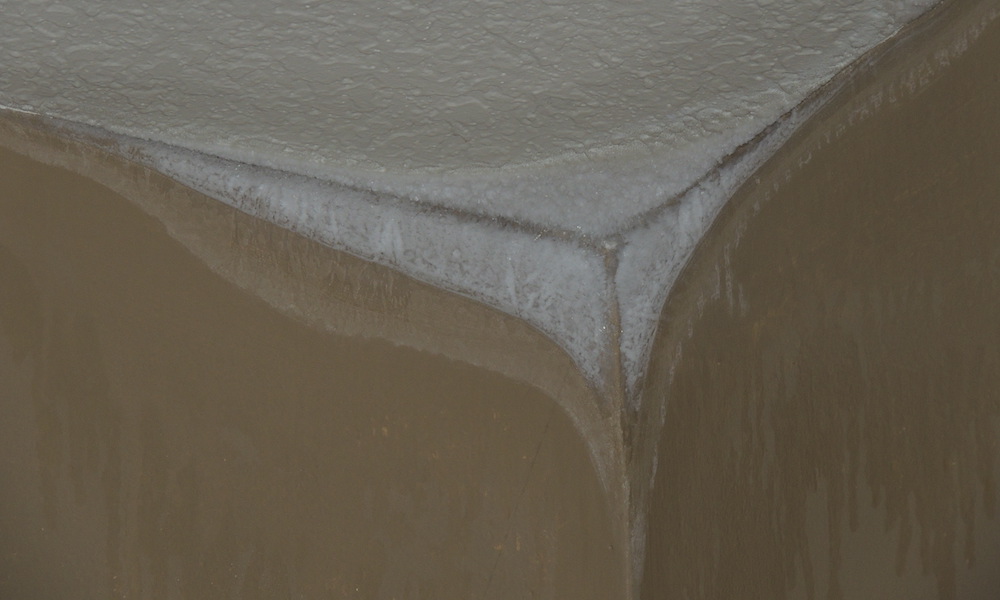
Cold air is dry air, right? Think about the humidity in your house in winter compared to what it is in summer. If you’re in a humid climate, it’s going to be drier in winter. Even in dry climates, it’s probably drier in winter. That’s because less water evaporates when it’s cold.* Of course, you already know that because adding heat is the way we dry things, right? Think blow-dryers and clothes dryers.
Water absorption with dry air
But doesn’t that leave us with a conundrum? Why would condensation (or moisture absorption in porous materials) happen if the air is dry?
The answer is pretty easy to grasp. It’s the same reason behind cold air still having enough heat in it to heat your home in winter when you use a heat pump. “Dry air” is a relative term. It doesn’t mean there’s no water vapor in the air. It just means that there’s less water vapor.
Moisture magnets
The key to wringing liquid water out of dry air is to use a magnet. No, not that kind of magnet. I’m talking about a moisture magnet. And that would be a cold surface.
Look at the lead photo above. I took that photo on a chilly winter day. The relative humidity in my hotel room was about 40%. The indoor temperature was 70°F. Using the psychrometric chart or an app that does the calculations, you can find that the dew point temperature for those conditions is about 45°F.
What does that tell us? If the air in that room finds any surface with a temperature lower than 45°F, water vapor from the air will start condensing on the surface. And the lower the temperature of the surface, the more condensation you’ll see.
In the case of that photo above, the metal-framed window becomes a magnet because it gets very cold. Heat flows right through it, making the temperature of that metal drop as the outdoor temperature drops. When it’s 30°F outdoors, that interior metal surface easily will be below the dew point temperature of 45°F.
Indoor air quality impacts
Windows are often the worst thermal performers in a building enclosure, so condensation there isn’t too surprising. In cold climates, it might even be frost. But where else might you have moisture magnets in your house?

Ceilings are one place where this can occur. Because of a poor insulation job or wind washing, the drywall on a ceiling could easily drop below the dew point temperature. The photo above shows frost at the edges and liquid water running down the walls because of cold, windy weather and lots of wind-washing through and beneath the attic insulation. (See article about that house for more details.)

If you don’t address a moisture magnet like that, you may end up with a serious microbial infestation. Yeah, I’m talking about mold. And that can affect your indoor air quality, which can affect your health. It also can affect your ability to sell the house.
Moisture problems like this also can occur in unheated rooms, which is one reason not to close vents in unused rooms. Poor circulation of heated air can keep surfaces cool enough to attract moisture and grow mold, too. Check behind your furniture and in closets, especially on exterior walls.
The sum and substance
Dry air still has plenty of water vapor in it. That water vapor can turn into liquid water (or adsorbed water; see chapter 6 of my book) when it finds cold surfaces. This can happen because of weak areas in the building enclosure, like metal-framed windows without a thermal break or wind-washed attic insulation.
There you have it. So-called dry air can cause moisture and indoor air quality problems. If you’re already at the low end of where you want your indoor relative humidity, the only solution is to warm those surfaces that are below the dew point temperature.
________________________________________________________________________
Allison A. Bailes III, PhD is a speaker, writer, building science consultant, and the founder of Energy Vanguard in Decatur, Georgia. He has a doctorate in physics and is the author of a popular book on building science. He also writes the Energy Vanguard Blog. You can follow him on Twitter at @EnergyVanguard. Photos courtesy of the author.
* Many people say it’s because the air can’t hold as much water when it’s cold, but the air really has nothing to do with it. I explained that in a previous article.
Weekly Newsletter
Get building science and energy efficiency advice, plus special offers, in your inbox.















3 Comments
Allison,
"Many people say it’s because the air can’t hold as much water when it’s cold, but the air really has nothing to do with it."
That revelation alone (which I only just had) was worth reading the blog for. Makes me wonder what other misapprehensions about basic building science I harbour?
I'm not sure the content of this article really supports the thesis that there's significant moisture in dry air. The example of air at 40%RH at 70F meets neither criteria of being cold nor dry, even in relative terms. Truly cold air is below freezing. Dry air at room temperature would be below 20%RH at most. 40%RH is right in the comfort zone, and thus in no way could be considered dry.
The problem in winter isn't that dry or cold air has moisture, it's that neither of the temperature nor the humidity of the indoor air tracks that of the outdoor air. Sure, the indoor humidity will be lower, but still not all that low.
“[Deleted]”
Log in or create an account to post a comment.
Sign up Log in